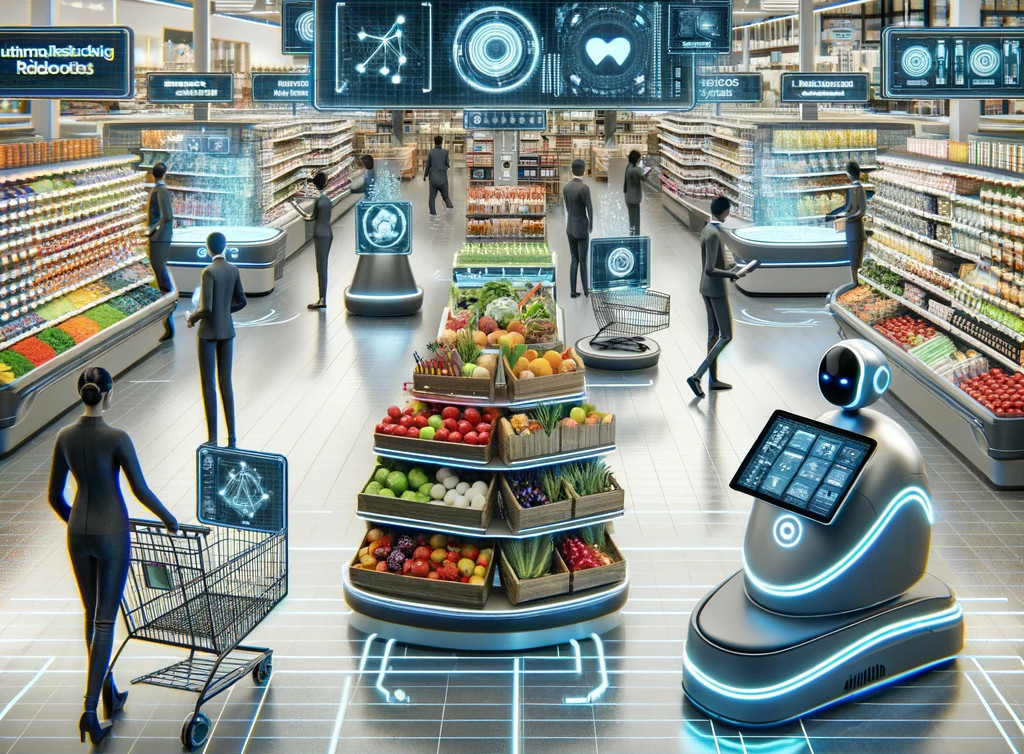AI-Vision in Retail:
11 Transformative Use Cases Elevating the Shopping Experience

AI Vision is not just transforming retail; it’s reshaping it from the ground up. Let’s delve deeper into each application to understand how they’re changing the industry. Each of these applications of AI Vision in retail represents a step towards a more efficient, customer-centric, and data-driven industry, with technology at the forefront of this transformation.
1. Automated Checkout Systems
AI Vision automates the checkout process by using image recognition to identify products as customers add them to their carts. This system leverages deep learning algorithms trained on vast datasets of product images, enabling the system to accurately recognize a wide range of items, even under varying lighting and orientations. The impact is a streamlined checkout experience, drastically reducing queue times and enhancing customer satisfaction.
2. Inventory Management and Stock Replenishment
Through constant visual monitoring of shelves using cameras, AI algorithms detect stock levels in real-time. These systems can discern between different products, track their quantity, and alert store managers when restocking is needed. Advanced algorithms can also predict future stock needs based on historical data, ensuring optimal inventory levels at all times.
3. Theft Prevention and Enhanced Store Security
Using pattern recognition and anomaly detection, AI Vision systems identify potential thefts and suspicious activities. By analyzing body language, movement patterns, and other visual cues, these systems can flag unusual behavior for human security personnel, thus reducing retail shrinkage and enhancing store security.
4. In-Store Customer Behavior Analysis
AI Vision tracks and analyzes customer movements and interactions within the store. By understanding traffic flow, dwell times, and interaction with products, retailers gain valuable insights into customer preferences and behavior. This data is crucial for optimizing store layout, product placement, and marketing strategies.
5. Personalized Customer Experiences
Facial recognition technology, combined with machine learning, allows stores to identify returning customers and their shopping habits. Respecting privacy concerns, this technology can be used to offer personalized shopping experiences, such as custom discounts and tailored product recommendations, enhancing customer loyalty.
6. Smart Fitting Rooms
AI-powered smart mirrors in fitting rooms provide interactive experiences by recommending sizes, styles, or accessories based on the items customers try on. These systems use image recognition to identify clothing items and suggest complementary products, thereby increasing sales and improving the shopping experience.
7. Retail Analytics
By analyzing visual data, AI Vision provides insights into customer demographics, store traffic, and peak hours. This information helps retailers in strategic decision-making like staffing, layout optimization, and targeted marketing, ultimately improving store performance and customer satisfaction.
8. Product Placement Optimization
AI Vision analyzes how customers interact with products in-store. Machine learning models use this data to understand patterns, such as which products are frequently picked up but not purchased, enabling retailers to optimize product placement and store layouts for maximum engagement and sales.
9. Customer Flow and Queue Management
AI Vision systems analyze and manage customer flow, optimizing in-store traffic and reducing queues. By understanding busy zones and customer movement patterns, retailers can enhance store layouts, improve customer experience, and manage staffing more effectively.
10. Real-Time Price Optimization
AI Vision systems can monitor competitor pricing, inventory levels, and customer demand in real-time. Machine learning algorithms analyze this data to dynamically adjust prices, ensuring competitiveness and maximizing profits. This real-time responsiveness is crucial in today’s fast-paced retail environment.
11. Customer Mood Analysis
AI Vision technologies can interpret customer expressions and body language to gauge mood and satisfaction. This information enables retailers to offer timely and personalized service, improving the overall shopping experience and customer satisfaction.